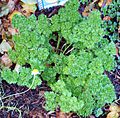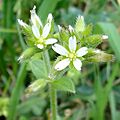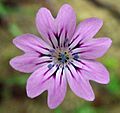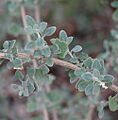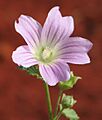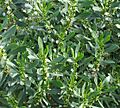Flora of the Houtman Abrolhos facts for kids
The Houtman Abrolhos is a group of islands off the coast of Western Australia. It's a special place with many different kinds of plants, also known as flora. This article will tell you about the amazing vascular plants found there. These are plants with special tissues to carry water and nutrients, like trees, shrubs, and grasses. We won't be looking at tiny plants like mosses or lichens here, as not much information has been published about them in the Abrolhos.
Scientists keep track of where each plant species grows. For plants found on only a few islands, they list the exact islands. If a plant grows on many islands (ten or more in a group), they just count how many islands it's on. Sometimes, islands don't have official names, so they are called by informal names in quotation marks.
You'll notice that some plants are highlighted with a grey background in the original list. This means they are naturalised species. This means they weren't originally from the Abrolhos but were brought there by people and now grow on their own. Some of these naturalised plants can even become weeds and cause problems for the native plants.
Discovering the Plants of Houtman Abrolhos
The Houtman Abrolhos islands are home to a wide variety of plants, each adapted to the island environment. Let's explore some of the interesting plant families and species you might find there.
Coastal Survivors: Aizoaceae and Amaranthaceae
Many plants in the Abrolhos are tough survivors, able to handle salty air and sandy soils.
- Coastal Pigface (Carpobrotus virescens) is a common sight. It spreads across 13 islands in the Wallabi Group, 25 in the Easter Group, and 23 in the Pelsaert Group.
- The Round-leaved Pigface is found on Pigeon Island, Leo Island, and Rat Island.
- A naturalised plant called Iceplant is very common, growing on 40 islands in the Wallabi Group, 18 in the Easter Group, and 30 in the Pelsaert Group.
- In the Amaranthaceae family, you'll find different types of Mulla Mulla plants (Ptilotus species) like Ptilotus divaricatus on East Wallabi Island and Ptilotus eriotrichus on East and West Wallabi Islands.
Apiaceae: The Carrot Family
Even the carrot family has representatives here!
- Apium annuum grows on East and West Wallabi Islands, and also on Alexander, Campbell, and Serventy Islands.
- Sea Celery (Apium prostratum) is found on Tattler Island and Middle Island.
- The Australian Carrot (Daucus glochidiatus) is quite widespread, appearing on many islands across all three groups.
- A naturalised plant, Petroselinum crispum, is found on Little Rat, Rat, and Roma Islands.
Tough Shrubs and Salt-Loving Plants
The islands feature many hardy shrubs and plants that thrive in salty conditions.
- The Dysentery Bush (Alyxia buxifolia) is a native shrub found on East Wallabi, Seagull, and West Wallabi Islands.
- The Leek Lily (Bulbine semibarbata) grows on several islands, including East Wallabi and Rat Island.
- The Coastal Daisybush (Olearia axillaris) is another common native shrub, seen on many islands like East Wallabi and North Island.
- The White Mangrove (Avicennia marina) is an important plant that grows in salty coastal areas. It's found on many islands in all three groups, helping to stabilise the shorelines.
Saltbushes and Samphires: Chenopodiaceae Family
The Chenopodiaceae family (now part of Amaranthaceae) is very important in the Abrolhos, as many of its members are salt-tolerant.
- The Grey Saltbush (Atriplex cinerea) is one of the most common plants, found on 27 islands in the Wallabi Group, 21 in the Easter Group, and 22 in the Pelsaert Group.
- The Marsh Saltbush (Atriplex paludosa) is also widespread, especially in the Wallabi Group.
- The Barrier Saltbush (Enchylaena tomentosa) is found on 26 islands in the Wallabi Group, 11 in the Easter Group, and 17 in the Pelsaert Group.
- Beaded Samphire (Sarcocornia quinqueflora) is another very common salt-loving plant, found on 17 islands in the Wallabi Group, 19 in the Easter Group, and 15 in the Pelsaert Group.
- The Coast Bonefruit (Threlkeldia diffusa) is incredibly widespread, growing on 33 islands in the Wallabi Group, 19 in the Easter Group, and 20 in the Pelsaert Group.
- Some naturalised plants from this family include Fat Hen and Nettle-leaf Goosefoot.
Grasses and Weeds: Poaceae and Other Families
Many types of grasses grow on the islands, both native and naturalised.
- Native grasses like Tall feather-grass are found on many islands in the Wallabi and Pelsaert Groups.
- Beach Spinifex (Spinifex longifolius) is a very important native grass that helps stabilise sand dunes. It's found on 15 islands in the Wallabi Group, 13 in the Easter Group, and several in the Pelsaert Group.
- Many naturalised grasses are also present, such as Wild Oat, Great Brome, and Couch. These can sometimes outcompete native plants.
Introduced Species and Their Impact
Several plants have been introduced to the Abrolhos islands and have become naturalised. Some of these are considered weeds because they can harm the native ecosystem.
- Mother of Millions (Bryophyllum delagoense) is a poisonous weed that was found to have taken over more than half of Rat and Pigeon Islands by 2000. This shows how quickly introduced species can spread.
- African Boxthorn (Lycium ferocissimum) is another declared noxious weed. It was found on several islands, and there's an ongoing program to remove it.
- Other naturalised plants include Wild Radish, Common Prickly Pear, and Athel Tree. While some might seem harmless, they can change the natural environment.
The Most Widespread Plant
The most common plant species in the Houtman Abrolhos is the Nitre Bush (Nitraria billardierei). It's found on an incredible 43 islands in the Wallabi Group, 30 in the Easter Group, and 34 in the Pelsaert Group! This shows how well it has adapted to the island conditions.
The flora of the Houtman Abrolhos is a fascinating mix of native survivors and introduced species. Understanding these plants helps us protect the unique environment of these special islands.
Images for kids







